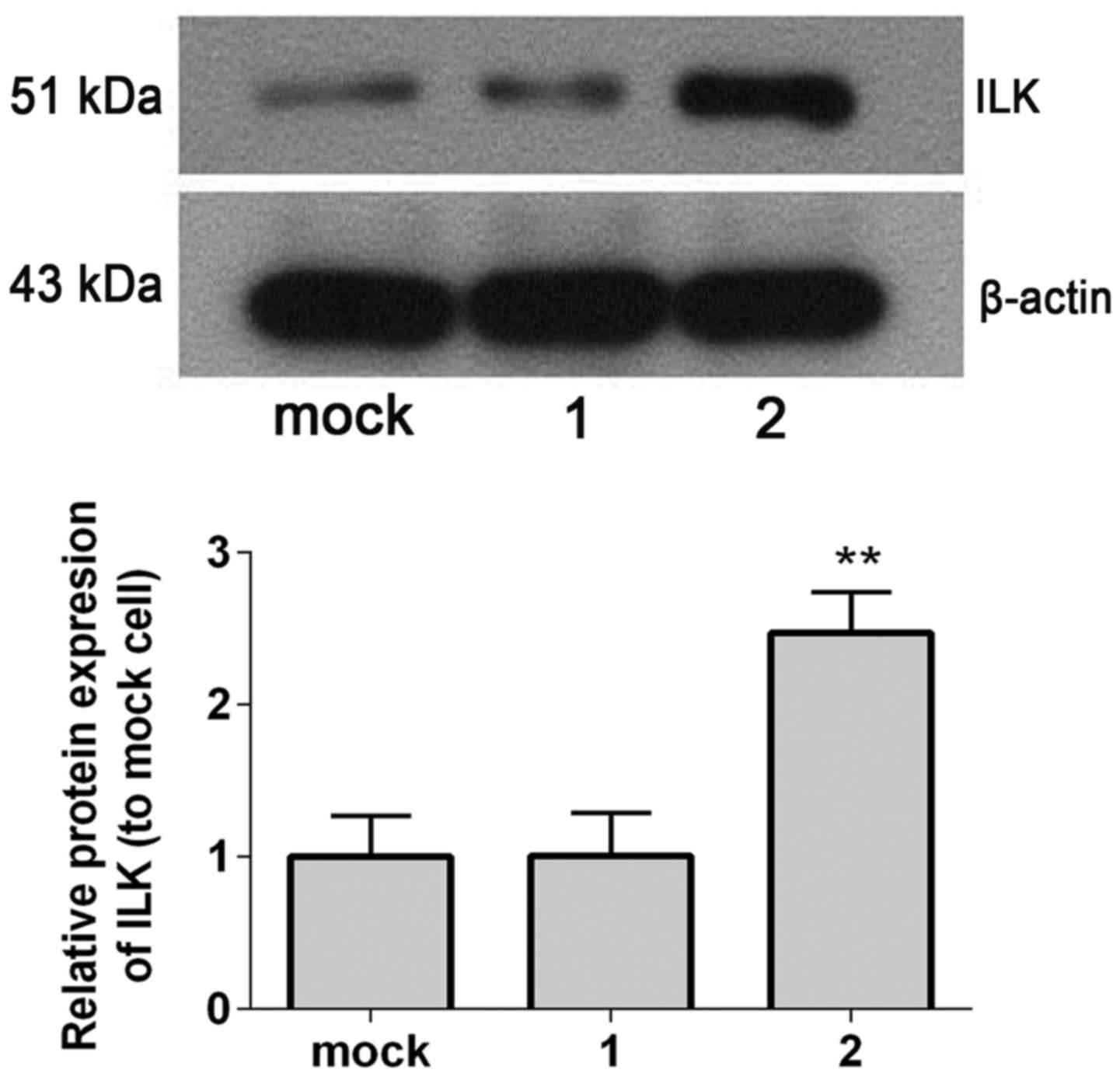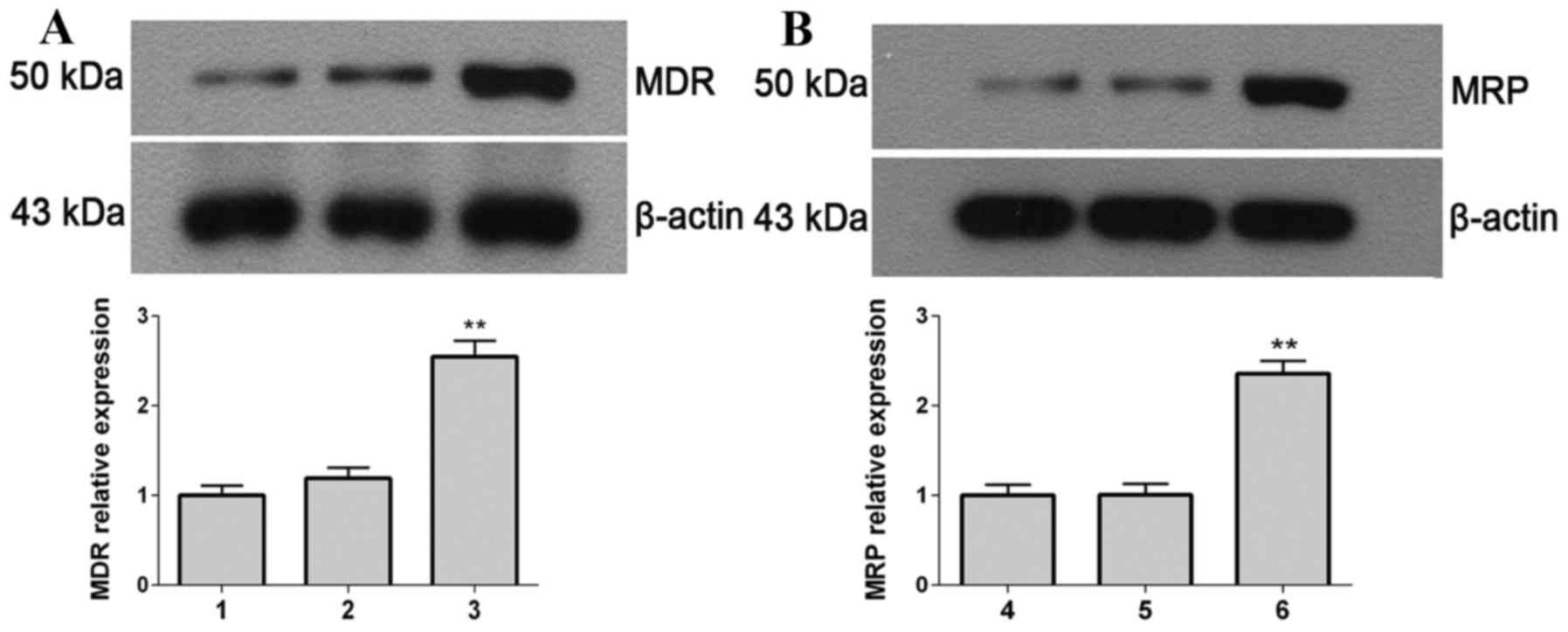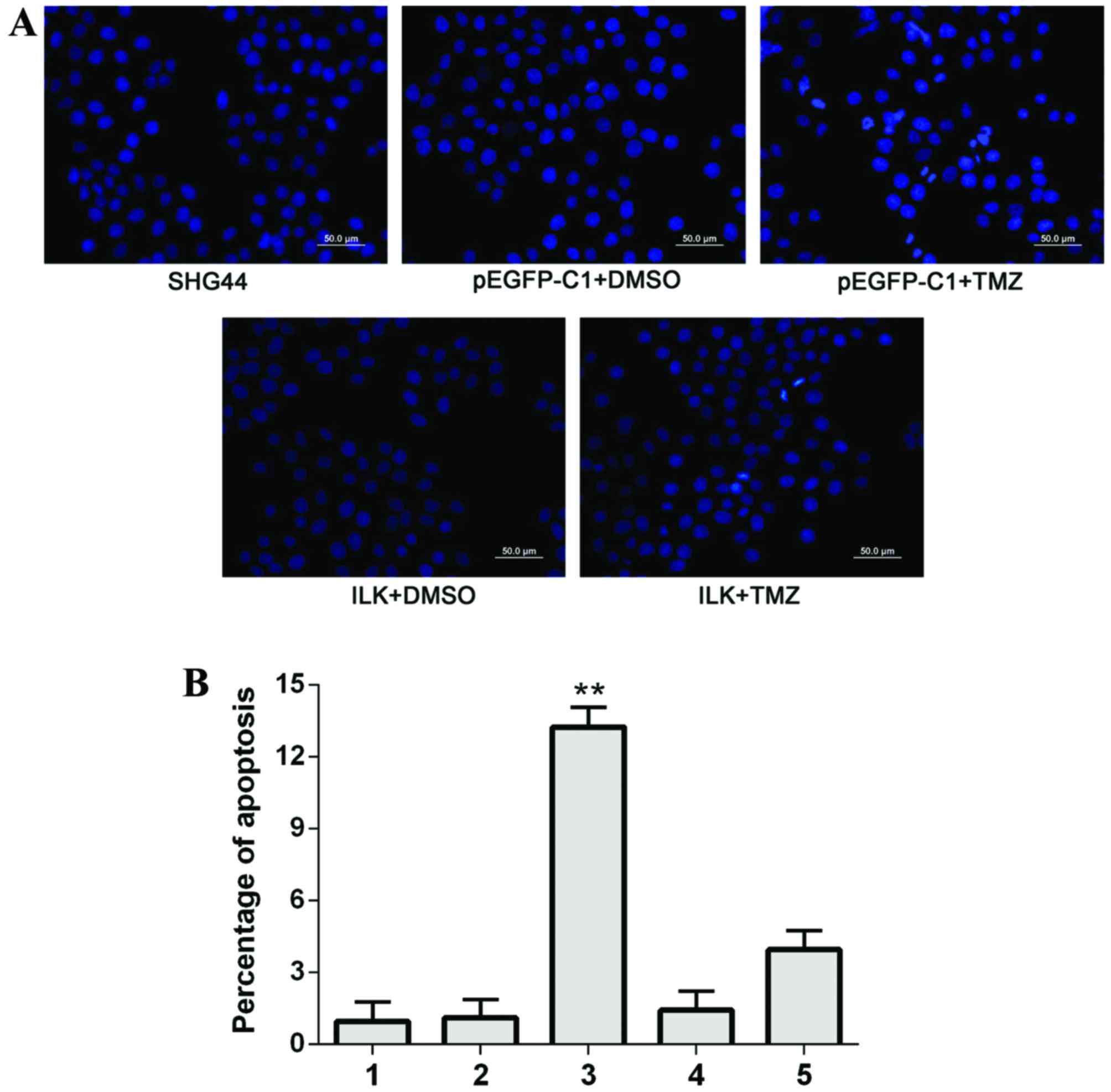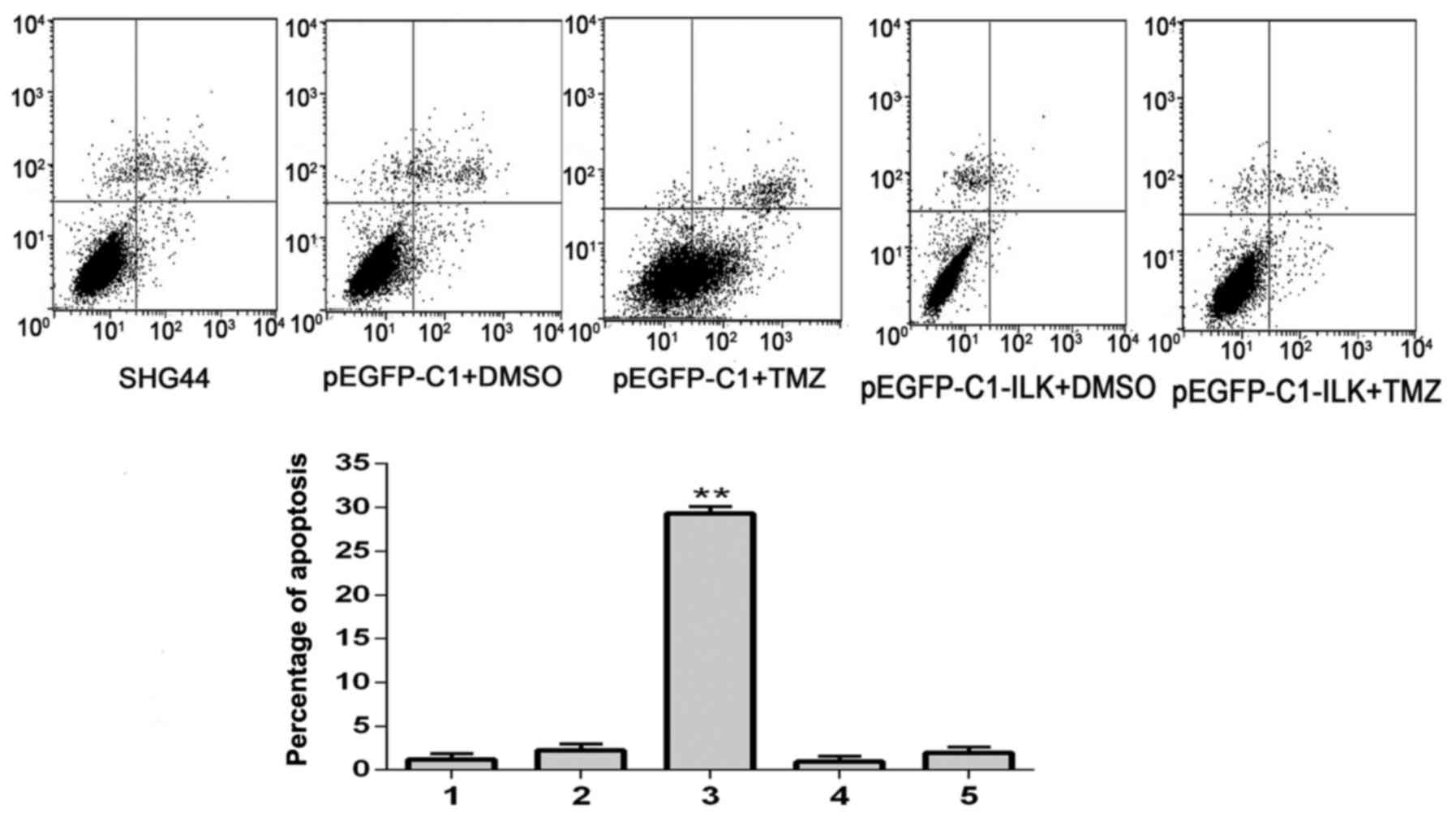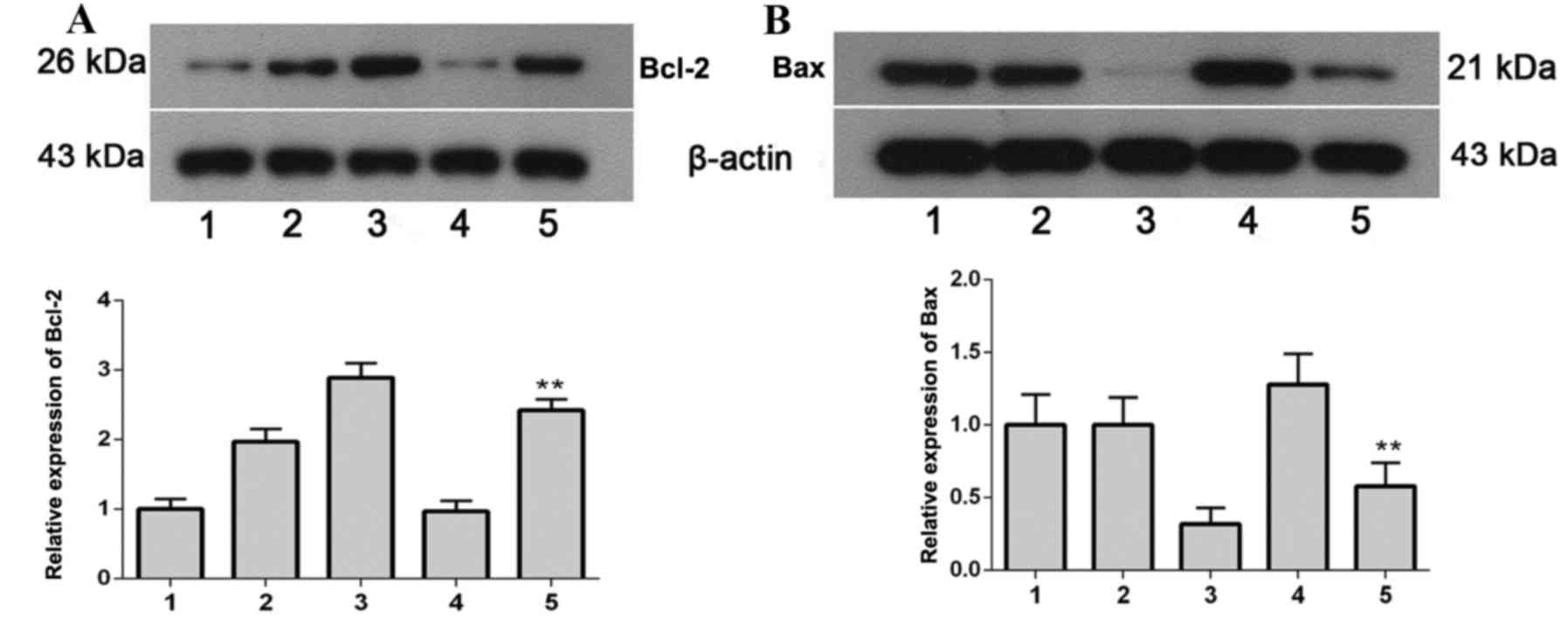Overexpression of ILK promotes temozolomide resistance in glioma cells
- Authors:
- Published online on: January 26, 2017 https://doi.org/10.3892/mmr.2017.6157
- Pages: 1297-1304
Abstract
Introduction
As the most common primary tumor of the central nervous system, glioma accounts for 46% of all intracranial tumors (1–3). The incidence of cerebral glioma is 3–10 in 100,000, comprising 1–3% of systemic malignant tumors. The median survival time of glioma patients who undergo surgery plus radiation and chemotherapy is only 8–11 months (4). Drug resistance to chemotherapy contributes to this poor prognosis (5); therefore, it is important to identify the mechanisms underlying drug resistance.
Integrin-linked kinase (ILK) was identified by Hannigan et al (6) using yeast two-hybrid screening. ILK cDNA is 1.8 kb long and encodes 452 amino acid residues, containing 3 structural units of Ser/Thr. ILK is normally expressed at low levels; ILK is activated upon adherence of extracellular matrix (ECM) to cells or by growth factors via the phosphoinositide 3-kinase (PI3K)-dependent signaling pathway. A previous study demonstrated that ILK overexpression in cells resulted in the activation of numerous signal transduction pathways (7). Overexpression of ILK in epithelial cells may lead to increased phosphorylation of protein kinase B (Akt) and glycogen synthase kinase 3 (8).
Previous studies have revealed that ILK may induce epithelial-mesenchymal transition, and promote the development of malignant tumor cells in bladder and pancreatic cancer (9–12). In addition, research performed by Duxbury et al (13) suggested that inhibition of the expression of ILK through RNA interference may enhance the sensitivity of pancreatic cancer cells to gemcitabine chemotherapy, This indicated that ILK expression may be associated with drug resistance of tumor cells. Overexpression of ILK has been detected in numerous human malignant tumors, and this over expression has been associated with poor prognosis (14–18). Few studies have investigated the association between ILK and drug resistance in glioma. The present study therefore investigated whether overexpression of ILK affected drug resistance to temozolomide in glioma cells.
Materials and methods
Cell line selection
U87 MG (Cell Bank of Type Culture Collection, Chinese Academy of Sciences, Shanghai, China), U373 (Shanghai Bioleaf Biotech Co., Ltd., Shanghai, China), U251 (Cell Bank of Type Culture Collection, Chinese Academy of Sciences), SHG-44 (Cell Bank of Type Culture Collection, Chinese Academy of Sciences) and T98 G (Co Bioer Biosciences Co., Ltd., Nanjing, China) human glioblastoma cell lines were cultured in RPMI-1640 medium (Gibco; Thermo Fisher Scientific, Inc., Waltham, MA, USA) containing 10% fetal bovine serum (FBS; Gibco; Thermo Fisher Scientific, Inc.) at 37°C and 5% CO2. These cell lines were used for analysis of ILK protein expression levels by western blotting, to select a cell line with low expression levels for subsequent experiments.
Western blotting
Total proteins were extracted from cells using NP-40 (Beyotime Institute of Biotechnology, Shanghai, China) and the protein concentration was determined using the Bicinchoninic Acid assay. Total proteins (50 µg) were subjected to 12% SDS-PAGE and transferred to polyvinylidene difluoride membranes (EMD Millipore, Billerica, MA, USA). Membranes were blocked with 5% skimmed milk for 1 h, and subsequently incubated with the following primary antibodies at 4°C overnight: Goat anti-ILK (1:5,000; clone, C-19; catalog no. sc-7516; Santa Cruz Biotechnology, Inc., Dallas, TX, USA), anti-multidrug resistance-associated protein (MRP; 1:5,000; cat. no. BA3340-2; rabbit anti human; Wuhan Boster Biological Technology, Ltd., Wuhan, China), anti-multidrug resistance protein (MDR; 1:1,000; cat. no. PB0162; rabbit anti human; Wuhan Boster Biological Technology, Ltd.), anti-B-cell lymphoma 2 (Bcl-2; 1:5,000; cat. no. BA0412; rabbit anti human; Wuhan Boster Biological Technology, Ltd) and anti-Bcl-2-associated X protein (Bax; 1:1,000; mouse anti human; cat. no. BA0315-2; Wuhan Boster Biological Technology, Ltd.). Membranes were washed three times with TBS and incubated with agoat anti rabbit, IgG-horseradish peroxidase (HRP; 1:5,000; cat. no. BA1054; Wuhan Boster Biological Technology, Ltd.) and goat anti mouse, IgG-HRP (1:5,000; cat. no. BA1050; Wuhan Boster Biological Technology, Ltd.) at 37°C for 45 min. The proteins were visualized by RapidStep™ enhanced chemiluminescence reagent (cat. no. 345818-100ML; Merck Millipore). The Odyssey® Imaging system (LI-COR Biosciences, Lincoln, NE, USA) was used for semi-quantitative analysis (Quantity One image analysis system (BioRad Laboratories, Inc., Hercules, CA, USA). β-actin (1:10,000; cat. no. BM0626; Wuhan Boster Biological Technology, Ltd.) served as the control.
Establishment of ILK stable transfected cell line
The commercial vector is the ILK Human cDNA ORF clone (NM_004517), which was purchased from OriGene Technologies, Inc. (Rockville, MD, USA; cat. no. RC20154L1). The primer sequences are as follows: Forward, 5′-AAGGTACTCGAGCTATGGACGACATTTAAG0AAG1-3′ and reverse, 5′-ATCCAAGAATTCTCTACTTGTCCTGCAATC0ATC1-3′. PCR was performed in a Mx3000 machine using the following thermocycling conditions: An initial denaturation step at 95°C for 5 min, followed by 30 cycles of 95°C for 30 sec and 55°C for 30 sec, and a final step of 72°C for 90 sec and 4°C for 5 min. The amplified ILK gene was separated and detected by 1% agarose gel electrophoresis. The target DNA fragment was purified and obtained using a DNA Recovery kit (catalog no. DP1702; BioTeke Corporation, Beijing, China).
TA cloning
The obtained ILK gene was inserted into thepUM-T vector (BioTeke Corporation). Briefly, 0.3 pmol ILK DNA was added to 1 µlpUM-T vector (0.03 pmol), and double-distilled H2O was added to a final volume of 5 µl. Subsequently, 5 µl Solution I (BioTeke Corporation; cat. no. DP6814) was added and incubated at 16°C for 30 min. The mixed solution was added to 100 µl JM109 competent cells (2×109 cell/ml; Sigma-Aldrich; Merck Millipore, Darmstadt, Germany), and cultured for 30 min on ice, followed by 42°C for 90 sec and 2 min on ice. Super Optimal Broth culture medium (800 µl; BioTeke Corporation) was added, and cells were cultured for 1 h at 37°C with oscillation. The cells were cultured on Fast-Media® Ampicillin Agar (InvivoGen, San Diego, CA, USA) plates containing X-gal and isopropyl β-D-1-thiogalactopyranoside. White colonies containing ILK were selected, the inserted ILK fragment was confirmed by PCR, and positive clones were selected and sequenced.
Plasmid extraction and genetic recombination
Targeted plasmids [T-ILK and p enhanced green fluorescent protein (EGFP)-C1 (Clontech Laboratories, Inc., Mountainview, CA, USA)] were extracted using a Plasmid DNA Maxi-Preparation kit (catalog no. DP1008, BioTeke Corporation) according to the manufacturer's protocol and plasmid concentration was determined by ultraviolet spectrophotometry. Double enzyme digestion for T-ILK and pEGFP-C1 was performed at designated cutting sites as described previously (19), using Fast Digest EcoRI and Fast Digest XholI restriction enzymes (Thermo Fisher Scientific, Inc.). Following conjugation and transfection, JM109 competent cells were cultured in kanamycin-containing agar plates, single clones containing pEGFP-C1-ILK were selected and the inserted fragment length was determined by PCR.
Recombined pEGFP-C1-ILK clones were verified by automated sequencing using an ABI Prism 3730 DNA Sequencer (Applied Biosystems; Thermo Fisher Scientific, Inc.) and transfected into glioma cells. Stably transfected cells were selected using geneticin. Transfection of the empty pEGFP-C1 plasmid served as a control.
Reverse transcription-PCR (RT-PCR) for ILK mRNA expression levels
Total RNA was extracted from transfected cells using TRIzol® reagent (Takara Biotechnology Co., Ltd., Dalian, China) according to the manufacturer's protocol. RNA quality was detected by ultraviolet spectrophotometry and agarose gel electrophoresis. Total RNA (1 µg) was reverse-transcribed to cDNA using the Takara RNA PCR kit (Takara Bio. Inc., Dalian, China; cat. no. RR019), and the ILK gene was amplified by PCR (Takara PCR Amplification kit (cat. no. RO11; Takara Bio. Inc.) with β-actin serving as a control. The primer sequences were as follows: Forward, 5′-ATGGAACCCTGAACAAACACT-3′ and reverse, 5′-AGCACATTTGGATGCGAGAAA-3′ for ILK; and forward, 5′-CTTAGTTGCGTTACACCCTTTCTTG-3′ and reverse, 5′-CTGTCACCTTCACCGTTCCAGTTT-3′ for β-actin. The thermocycling conditions were as follows: An initial denaturation step at 95°C for 5 min, followed by 30 cycles of 95°C for 20 sec and 60°C for 20 sec, and a final step at 72°C for 30 sec and 4°C for 5 min. The amplified products were separated by 1.5% agarose gel and imaged using the Odyssey®Imaging system (LI-COR Biosciences).
MTT assay
Stably transfected (pEGFP-C1-ILK) cells were cultured in RPMI-1640 medium containing 10% FBS, and seeded into 96-well plates at a density of 3×103 cells per well. TMZ (Sigma-Aldrich; Merck Millipore; dissolved in DMSO (10 mg in 0.5 ml) and then diluted to 10 umol/l prior to experiment) was subsequently added. Cells were divided into five groups (5 wells/group): pEGFP-C1-ILK, pEGFP-C1+0.1% dimethyl sulfoxide (DMSO), pEGFP-C1+100 µM TMZ, pEGFP-C1-ILK+ 0.1% DMSO, pEGFP-C1-ILK+100 µM TMZ. An MTT assay was performed at 12, 24, 48 and 72 h after treatment. The medium was removed from each well and 100 µl MTT (0.2 mg/ml in PBS) was added in the absence of light; formazan crystals were produced over a 4-h incubation period at 37°C. To dissolve crystals, 200 µl DMSO was added to each well and the optical density (OD) at a wavelength of 490 nm was measured on a Tecan Spectra Fluor spectrophotometer (Tecan, Männedorf, Switzerland).
Hoechst staining
Hoechst staining was performed on the SHG44, pEGFP-C1+0.1% DMSO, pEGFP-C1+100 µM TMZ, pEGFP-C1-ILK +0.1% DMSO and pEGFP-C1-ILK +100 µM TMZ groups 72 h following treatment. Cells were fixed on glass slides and stained with Hoechst for 5 min. Cells were subsequently washed twice with PBS, treated with fluorescence quenching liquid, coverslipped and immediately observed under a fluorescence microscope (magnification, ×400). A total of 5 random fields of vision were selected, and, the number of normal cells in each were counted, allowing for the average number to be calculated. Staining results were analyzed (the nuclei were pale blue and uniformly arranged in normal cells) and then analyzed in conjunction with flow cytometry results.
Flow cytometry
Flow cytometry was performed in the SHG44, pEGFP-C1+0.1% DMSO, pEGFP-C1+100 µM TMZ, pEGFP-C1-ILK + 0.1% DMSO and pEGFP-C1-ILK +100 µM TMZ groups. The cells were inoculated in a T25 culture flask until the cells adhered to the wall, following which TMZ and DMSO were added. After 72 h of treatment, cells were washed twice with PBS, digested by trypsin and centrifuged at 800 × g, 24°C for 5 min. All components of the Annexin V-FITC/PI apoptosis double staining kit; cat. no. LHK601-050; JiaMay Biotech, Ltd., Beijing, China) were added sequentially, before incubating at room temperature for 15 min, and analyzed within 1 h by flow cytometer (FACSCalibur; cat. no. FACS101; BD Biosciences, Franklin Lakes, NJ, USA) using FlowJo software (version, 7.6.1; FlowJo, LLC, Ashland, OR, USA).
Measurement of caspase-3 activity
A Caspase-3 Detection kit (Beyotime Institute of Biotechnology) was used to detect the activity of caspase-3. The transfected cells were transferred to a 6-well plate at a density of 1×106/ml, and LAMD3100 (25 µl) was added when cell confluence reached 65%. Following culture for 12 h, cells were washed in PBS, homogenized, lysed by NP-40 (Beyotime Institute of Biotechnology) and incubated on ice. Ac-DEVD-AMC (5 µl; AAT Bioquest, Inc., Sunnyvale, CA, USA) was added to a reaction solution containing 50 µl reaction buffer and 50 µl protein solution, and incubated at 37°C for 4 h. The absorption was measured at a wavelength of 405 nm using an enzyme standard meter (ELX-800; BiotekInstruments, Winooski, USA) andcaspase-3 activity was calculated using a standard curve.
Statistical analysis
SPSS software version 18.0 (SPSS, Inc., Chicago, IL, USA) was used to analyze the data. Data are presented as the mean ± standard deviation. Analysis of variance analysis (along with Bonferroni adjustment as post-hoc analysis) and independent t-tests were performed to compare groups. P<0.05 was considered to indicate a statistically significant difference.
Results
Cell selection
Western blot analysis revealed that the protein expression levels of ILK were lowest in the SHG-44 cell line (Fig. 1); therefore, subsequent experiments were performed on SHG-44 cells.
Amplification and transfection of ILK
The complete ILK gene fragment (length, 1.8 kb) was amplified by PCR, and agarose gel electrophoresis results demonstrated that the size of the PCR product was consistent with the expected size of the ILK gene (Fig. 2A), indicating that the ILK gene was amplified.
The recombinant plasmid pEGFP-C1-ILK was identified by PCR, and the obtained PCR fragments were consistent with the expected size of 1.8 kb (Fig. 2B). In addition, analysis confirmed that the inserted fragment length presented no gene mutation in recombinant colonies (Fig. 2C). Furthermore, gene sequencing was performed to confirm the ILK gene segment in the ILK plasmid vector.
mRNA expression levels of ILK in SHG-44 transfected cells
RT-PCR results demonstrated that ILK mRNA expression levelsin stable transfected SHG-44 cellswere significantly greater compared with the controls (mock-transfected and empty vector-transfected SHG-44 cells; P=0.0067; Fig. 3).
Protein expression levels of ILK in SHG-44 transfected cells
Western blot analysis revealed that ILK protein expression levels were significantly increased in ILK stable transfected cells compared with controls (mock-transfected and empty vector-transfected SHG-44 cells; P=0.005; Fig. 4).
Protein expression levels of MDR and MRP
The protein expression levels of MDR (Fig. 5A) and MRP (Fig. 5B) were detected by western blot analysis. The protein expression levels of MDR and MRP in the stable transfected cells were significantly greater compared with the controls (mock-transfected and empty vector-transfected SHG-44 cells; P=0.0082). This demonstrated that the transfected cells increase their resistance ability to TMZ through promoting the expression of MDR and MRP.
Cell growth measured by MTT
Cell proliferation was evaluated using an MTT assay; results are presented in Table I. In thepEGFP-C1-ILK transfected group (subsequently abbreviated to ILK), the OD values at 24, 48 and 72 h following TMZ treatment group were significantly greater compared with the pEGFP-C1+TMZ group (P=0.0074); at the same time points, the OD values in the ILK+DMSO group were increased compared with the pEGFP C1+DMSO group (P=0.0063). These results suggested that overexpression of ILK promotesSHG-44 human glioma cell proliferation.
Apoptosis of cells detected by Hoechst staining
Under a fluorescence microscope, apoptotic cells revealed nuclear dense staining or chunky dense staining; apoptosis occurred to the greatest extent in the pEGFP-C1+TMZ group. No significant differences were observed in the percentage of apoptosis between the SHG-44 and pEGFP-C1+DMSO groups; the percentage of apoptotic cells in the ILK+TMZ group was significantly reduced compared with the pEGFP-C1+TMZ group (Fig. 6). These results indicated that overexpression of ILK reduced apoptosis in glioma cells, reducing their sensitivity to TMZ.
Flow cytometry
Flow cytometric analysis demonstrated that the percentage of early apoptotic cells (lower right quadrant) was greatest in the pEGFP-C1+TMZ group; the percentage of these cells was significantly reduced in the ILK+TMZ group (P=0.001; Fig. 7). These results suggested that the overexpression of ILK may decrease apoptosis in glioma cells treated with TMZ, and therefore decrease the sensitivity of cells to TMZ.
Protein expression levels of Bcl-2 and Bax
The protein expression levels of Bcl-2 (Fig. 8A) and Bax (Fig. 8B) were detected by western blot analysis. The protein expression levels of Bcl-2, an anti-apoptotic protein, were significantly increased (P=0.0093) in the ILK+TMZ group compared with the pEGFP-C1+TMZ group; whereas the protein expression levels of the pro-apoptotic protein Bax were significantly decreased (P=0.0068) in the ILK+TMZ group compared with the pEGFP-C1+TMZ group. These results indicated that ILK increased expression of anti-apoptotic proteins, and decreased expression of pro-apoptotic proteins, thus reducing apoptosis in glioma cells and their sensitivity to TMZ.
Caspase-3 activity
The activity of caspase-3 in the ILK+TMZ group was significantly reduced compared with the pEGFP-C1+TMZ group (P=0.0078; Table II). These results suggested that ILK decreased the activity of caspase-3, thus decreasing apoptosis in glioma cells and their sensitivity to TMZ.
Discussion
The occurrence and development of tumors requires cells to perform various functions, including proliferation, independent growth, anchoring, apoptosis, angiogenesis, invasion and metastasis. ILK, a unique intracellular regulator, may contribute to these functions. In addition, ILK interacts with the protein kinase of cell adhesion receptors, as well as integrin and actin cytoskeleton growth factors. Evidence indicates that ILK may be a cancer gene, and that it may promote tumor cell survival or tumor progression by regulating various signaling pathways (20).
ILK serves a complex role in numerous cellular functions, including proliferation, motility, invasion, metastasis and angiogenesis (21,22). A study by Lee et al (23) demonstrated that ILK regulates phosphorylation of Akt in phosphatase and tensin homolog deficient prostate cancer and breast cancer cells. Overexpression of ILK has been associated with tumor progression and poor prognosis in patients with rectal cancer (24). Monferran et al (25) revealed that the sensitivity of glioma cells to ionizing radiation was regulated by RhoB and ILK. Lanvin et al (26) demonstrated that ILK altered the radiation sensitivity of glioma via the regulation of the hypoxia-inducible factor 1α and survivin pathway and the mediation of mitochondrial death. These findings indicated that ILK may be a potential target for the treatment of glioma (20). The aim of the present study was to investigate biological behaviors, including proliferation and apoptosis, in ILK stable transfected SHG-44 cells in vitro, and investigate the sensitivity of transfected glioma cells to TMZ.
In the present study, western blot analysis and RT-PCR revealed that the expression levels of ILK protein and mRNA in the stable transfected ILK cell line was significantly greater compared with the mock- and empty vector-transfected groups, which indicated the successful construction of the ILK stable transfected cell line. The protein expression levels of MDR and MRP were significantly increased in ILK-transfected cells, which made their resistance ability to TMZ increased.
Bcl-2 family proteins are important regulatory factors in the endogenous mitochondrial-dependent apoptosis pathway. In the past 20 years, in vitro and in vivo studies have revealed that Bcl-2 family proteins serve important roles in the drug resistance of tumor cells. The endogenous apoptosis pathway may be activated by numerous factors, including chemotherapy agents, growth deprivation, mitochondria membrane breakdown and apoptosis factors, particularly the release of cytochrome C from mitochondria into the cytoplasm (27). The mitochondrial apoptosis pathway is mediated by a complex network composed of pro- and anti-apoptotic proteins of the Bcl-2 family (28). Through upregulating anti-apoptotic proteins or downregulating pro-apoptotic proteins, the mitochondrial apoptotic pathway may determine whether gliomas are sensitive to radiation and chemotherapy (29). Western blot analysis demonstrated that ILK increased the expression of the anti-apoptotic protein Bcl-2 significantly and decreased the expression of the pro-apoptotic protein Baxin human glioma cells.
MTT assays revealed that following 24, 48 and 72 h of treatment with TMZ or DMSO, OD values in the ILK stable transfected group were significantly greater compared with the empty vector group, which indicated that the overexpression of ILK may promote the proliferation of TMZ-treated glioma cells. Hoechst staining revealed that the percentage of apoptotic cells in the ILK stable transfected group was significantly decreased compared with the empty vector group. Therefore, ILK may promote proliferation and decrease apoptosis in TMZ-treated cells.
Song et al (30) indicated that ILK influenced the MDR gene expression via the PI3K-Akt and mitogen-activated protein kinase-extracellular signal-regulated kinase signaling pathways, regulating the progress of gastric cancer. It is well known that caspase activation is a typical marker of early and late apoptosis. The activity of caspase-3 is an important indicator to determine whether apoptosis is occurring in cells or tissues (31). Duxbury et al (13) demonstrated that ILK increased gemcitabine resistance in pancreatic cancer cells, and that knockdown of ILK increased the sensitivity of pancreatic cancer cells to gemcitabine via increasing caspase-3-mediated apoptosis. Therefore, ILK may regulate the sensitivity of glioma cells to TMZ. The results of the present study revealed that the activity of caspase-3 was significantly reduced in the ILK stable transfected cells compared with the empty vector group. The expression of ILK in glioma cells may decrease apoptosis in tumor cells via the downregulation of caspase-3 activity, thereby reducing the sensitivity of tumor cells to TMZ.
In conclusion, the results of the present study demonstrated that overexpression of ILK in SHG-44 glioma cells downregulated the expression of the anti-apoptotic protein Bcl-2, increased the expression of Bax, and decreased the activity of the key enzyme caspase-3, thus reducing the apoptosis of tumor cells, promoting their proliferation, and reducing the sensitivity of SHG-44 glioma cells to TMZ. The present results suggested that ILK may serve as a potential therapeutic target for glioma.
Acknowledgements
The present study was supported by the Doctor Startup Foundation in Liaoning Province (grant no. 201501101) and the Technology Startup Foundation of The First Affiliated Hospital of Liaoning Medical University (grant no. FYK201214).
References
|
DeAngelis LM: Brain tumors. N Engl J Med. 344:114–123. 2001. View Article : Google Scholar : PubMed/NCBI | |
|
Van Meir EG, Hadjipanayis CG, Norden AD, Shu HK, Wen PY and Olson JJ: Exciting new advances in neuro-oncology: The avenue to a cure for malignant glioma. CA Cancer J Clin. 60:166–193. 2010. View Article : Google Scholar : PubMed/NCBI | |
|
Asklund T, Malmstrom A, Bergqvist M, Björ O and Henriksson R: Brain tumors in Sweden: Data from a population-based registry 1999–2012. Acta Oncol. 54:377–384. 2015. View Article : Google Scholar : PubMed/NCBI | |
|
Stupp R, Tonn JC, Brada M and Pentheroudakis G: ESMO Guidelines Working Group: High-grade malignant glioma: ESMO clinical practice guidelines for diagnosis, treatment and follow-up. Ann Oncol. 21:(Suppl 5). v190–v193. 2010. View Article : Google Scholar : PubMed/NCBI | |
|
Mrugala MM, Adair J and Kiem HP: Temozolomide: Expanding its role in brain cancer. Drugs Today (Barc). 46:833–846. 2010. View Article : Google Scholar : PubMed/NCBI | |
|
Hannigan GE, Leung-Hagesteijn C, Fitz-Gibbon L, Coppolino MG, Radeva G, Filmus J, Bell JC and Dedhar S: Regulation of cell adhesion and anchorage-dependent growth by a new beta 1-integrin-linked protein kinase. Nature. 379:91–96. 1996. View Article : Google Scholar : PubMed/NCBI | |
|
Dedhar S: Cell-substrate interactions and signaling through ILK. Curr Opin Cell Biol. 12:250–256. 2000. View Article : Google Scholar : PubMed/NCBI | |
|
Schmitz M, Grignard G, Margue C, Dippel W, Capesius C, Mossong J, Nathan M, Giacchi S, Scheiden R and Kieffer N: Complete loss of PTEN expression as a possible early prognostic marker for prostate cancer metastasis. Int J Cancer. 120:1284–1292. 2007. View Article : Google Scholar : PubMed/NCBI | |
|
Gil D, Ciołczyk-Wierzbicka D, Dulińska-Litewka J, Zwawa K, McCubrey JA and Laidler P: The mechanism of contribution of integrin linked kinase (ILK) to epithelial-mesenchymal transition (EMT). Adv Enzyme Regul. 51:195–207. 2011. View Article : Google Scholar : PubMed/NCBI | |
|
Matsui Y, Assi K, Ogawa O, Raven PA, Dedhar S, Gleave ME, Salh B and So AI: The importance of integrin-linked kinase in the regulation of bladder cancer invasion. Int J Cancer. 130:521–531. 2012. View Article : Google Scholar : PubMed/NCBI | |
|
Serrano I, McDonald PC, Lock FE and Dedhar S: Role of the integrin-linked kinase (ILK)/Rictor complex in TGFβ-1-induced epithelial-mesenchymal transition (EMT). Oncogene. 32:50–60. 2013. View Article : Google Scholar : PubMed/NCBI | |
|
Chen D, Zhang Y, Zhang X, Li J, Han B, Liu S, Wang L, Ling Y, Mao S and Wang X: Overexpression of integrin-linked kinase correlates with malignant phenotype in non-small cell lung cancer and promotes lung cancer cell invasion and migration via regulating epithelial-mesenchymal transition (EMT)-related genes. Acta Histochem. 115:128–136. 2013. View Article : Google Scholar : PubMed/NCBI | |
|
Duxbury MS, Ito H, Benoit E, Waseem T, Ashley SW and Whang EE: RNA interference demonstrates a novel role for integrin-linked kinase as a determinant of pancreatic adenocarcinoma cell gemcitabine chemoresistance. Clin Cancer Res. 11:3433–3438. 2005. View Article : Google Scholar : PubMed/NCBI | |
|
Dai DL, Makretsov N, Campos EI, Huang C, Zhou Y, Huntsman D, Martinka M and Li G: Increased expression of integrin-linked kinase is correlated with melanoma progression and poor patient survival. Clin Cancer Res. 9:4409–4414. 2003.PubMed/NCBI | |
|
Sawai H, Okada Y, Funahashi H, Matsuo Y, Takahashi H, Takeyama H and Manabe T: Integrin-linked kinase activity is associated with interleukin-1 alpha-induced progressive behavior of pancreatic cancer and poor patient survival. Oncogene. 25:3237–3246. 2006. View Article : Google Scholar : PubMed/NCBI | |
|
Li J, Zhang H, Wu J, Guan H, Yuan J, Huang Z and Li M: Prognostic significance of integrin-linked kinase1 overexpression in astrocytoma. Int J Cancer. 126:1436–1444. 2010.PubMed/NCBI | |
|
Yu J, Shi R, Zhang D, Wang E and Qiu X: Expression of integrin-linked kinase in lung squamous cell carcinoma and adenocarcinoma: Correlation with E-cadherin expression, tumor microvessel density and clinical outcome. Virchows Arch. 458:99–107. 2011. View Article : Google Scholar : PubMed/NCBI | |
|
Zhao D, Tang XF, Yang K, Liu JY and Ma XR: Over-expression of integrin-linked kinase correlates with aberrant expression of Snail, E-cadherin and N-cadherin in oral squamous cell carcinoma: Implications in tumor progression and metastasis. Clin Exp Metastasis. 29:957–969. 2012. View Article : Google Scholar : PubMed/NCBI | |
|
Zhuang X, Lv M, Zhong Z, Zhang L, Jiang R and Chen J: Interplay between intergrin-linked kinase and ribonuclease inhibitor affects growth and metastasis of bladder cancer through signaling ILK pathways. J Exp Clin Cancer Res. 35:1302016. View Article : Google Scholar : PubMed/NCBI | |
|
Hannigan G, Troussard AA and Dedhar S: Integrin-linked kinase: A cancer therapeutic target unique among its ILK. Nat Rev Cancer. 5:51–63. 2005. View Article : Google Scholar : PubMed/NCBI | |
|
Persad S and Dedhar S: The role of integrin-linked kinase (ILK) in cancer progression. Cancer Metastasis Rev. 22:375–384. 2003. View Article : Google Scholar : PubMed/NCBI | |
|
McDonald PC, Fielding AB and Dedhar S: Integrin-linked kinase-essential roles in physiology and cancer biology. J Cell Sci. 121:3121–3132. 2008. View Article : Google Scholar : PubMed/NCBI | |
|
Lee SL, Chou CC, Chuang HC, Hsu EC, Chiu PC, Kulp SK, Byrd JC and Chen CS: Functional role of mTORC2 versus integrin-linked kinase in mediating Ser473-Akt phosphorylation in PTEN-negative prostate and breast cancer cell lines. PLoS One. 8:e671492013. View Article : Google Scholar : PubMed/NCBI | |
|
Li R, Liu B, Yin H, Sun W, Yin J and Su Q: Overexpression of integrin-linked kinase (ILK) is associated with tumor progression and an unfavorable prognosis in patients with colorectal cancer. J Mol Histol. 44:183–189. 2013. View Article : Google Scholar : PubMed/NCBI | |
|
Monferran S, Skuli N, Delmas C, Favre G, Bonnet J, Cohen-Jonathan-Moyal E and Toulas C: Alphavbeta3 and alphavbeta5 integrins control glioma cell response to ionising radiation through ILK and RhoB. Int J Cancer. 123:357–364. 2008. View Article : Google Scholar : PubMed/NCBI | |
|
Lanvin O, Monferran S, Delmas C, Couderc B, Toulas C and Cohen-Jonathan-Moyal E: Radiation-induced mitotic cell death and glioblastoma radioresistance: A new regulating pathway controlled by integrin-linked kinase, hypoxia-inducible factor 1 alpha and survivin in U87 cells. Eur J Cancer. 49:2884–2891. 2013. View Article : Google Scholar : PubMed/NCBI | |
|
Hotchkiss RS, Strasser A, McDunn JE and Swanson PE: Cell death. N Engl J Med. 361:1570–1583. 2009. View Article : Google Scholar : PubMed/NCBI | |
|
Zhang T and Saghatelian A: Emerging roles of lipids in BCL-2 family-regulated apoptosis. Biochim Biophys Acta. 1831:1542–1554. 2013. View Article : Google Scholar : PubMed/NCBI | |
|
Kouri FM, Jensen SA and Stegh AH: The role of Bcl-2 family proteins in therapy responses of malignant astrocytic gliomas: Bcl2L12 and beyond. ScientificWorldJournal. 2012:8389162012. View Article : Google Scholar : PubMed/NCBI | |
|
Song W, Jiang R and Zhao CM: Role of integrin-linked kinase in multi-drug resistance of human gastric carcinoma SGC7901/DDP cells. Asian Pac J Cancer Prev. 13:5619–5625. 2012. View Article : Google Scholar : PubMed/NCBI | |
|
Mazumder S, Plesca D and Almasan A: Caspase-3 activation is a critical determinant of genotoxic stress-induced apoptosis. Methods Mol Biol. 414:13–21. 2008.PubMed/NCBI |






